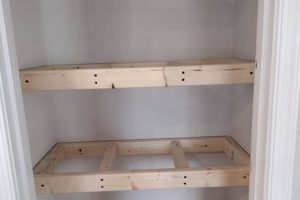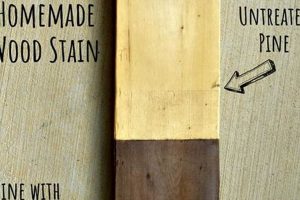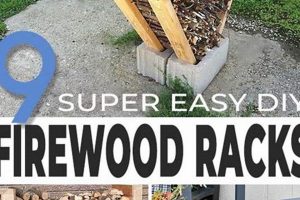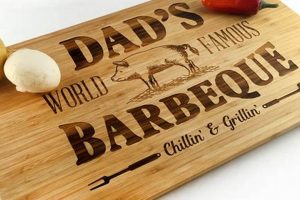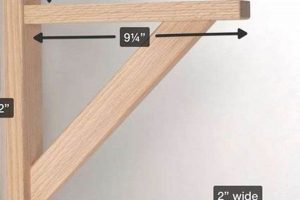A self-assembled heating appliance, typically constructed from readily available materials like metal barrels or scrap steel, serves the function of combustion for wood fuel. These units provide an alternative method for heating spaces, particularly useful in situations where conventional heating systems are unavailable or cost-prohibitive. An example might involve repurposing a 55-gallon steel drum, modifying it with a door, chimney connection, and air intake, to create a functional space heater for a workshop.
The significance of these constructions lies in their potential for providing affordable heat and promoting self-sufficiency. Historically, resourcefulness in creating heating solutions has been a necessity in areas with limited access to fuel or financial resources. Such resourceful heating methods can reduce reliance on centralized energy sources and provide a means of heating during power outages or emergencies. Furthermore, individuals with fabrication skills and access to materials can benefit from the economic advantages of constructing their own heating apparatus.
The subsequent sections will delve into the specific considerations involved in the design and construction of these heating units, including material selection, safety protocols, efficiency enhancements, and regulatory compliance. These factors are paramount to ensuring both effective heating performance and the prevention of hazardous operating conditions.
Essential Considerations for Constructing Heating Appliances
The following provides crucial guidance for individuals considering the fabrication of a wood-burning heating device. Adherence to these points is vital for ensuring safety, efficiency, and regulatory compliance.
Tip 1: Material Selection: Utilize heavy-gauge steel for the firebox construction. Thinner materials are prone to warping and premature failure due to the intense heat. For example, a quarter-inch steel plate offers superior durability compared to 16-gauge sheet metal.
Tip 2: Secure Welding: Employ professional welding techniques to ensure airtight seams. Porous welds allow for uncontrolled air intake, leading to inefficient combustion and potential fire hazards. Leak testing with soapy water and compressed air can identify weaknesses.
Tip 3: Proper Chimney Installation: Ensure the chimney system meets local building codes and fire safety standards. A properly sized and insulated chimney facilitates adequate draft and minimizes creosote buildup. Utilize double-wall or triple-wall chimney pipes for optimal performance and safety.
Tip 4: Adequate Air Intake Control: Incorporate a controllable air intake mechanism. This allows for precise regulation of the combustion rate and heat output. A sliding damper or adjustable air vent provides the necessary control.
Tip 5: Strategic Baffle Placement: Install baffles within the firebox to increase heat retention and promote more complete combustion. Baffles redirect exhaust gases, extending their contact time with the fire and extracting more heat.
Tip 6: Implement Safety Clearances: Maintain the mandated minimum clearances between the unit and combustible materials. Consult local building codes for specific requirements. Using heat shields and non-combustible flooring can mitigate fire risks.
Tip 7: Consider Fire Resistance: Apply high-temperature paint rated for stove use. This protects the metal from corrosion and adds a professional finish. Regular inspections and maintenance are critical to identifying and addressing potential hazards early.
Diligent application of these principles enhances the safety and functionality of the constructed heating appliance. Prioritizing robust construction methods and adhering to established safety guidelines minimizes the risks associated with solid fuel combustion.
The next step involves examining the regulatory aspects and the importance of seeking professional consultation before commencing construction.
1. Material Durability
Material durability constitutes a foundational element in the successful and safe fabrication of a wood-burning heating apparatus. The inherent characteristics of the materials employed directly dictate the unit’s lifespan, its resistance to thermal stress, and its overall operational safety. Inferior materials, susceptible to rapid degradation under high temperatures, pose significant risks, including structural failure and the potential for fire hazards. The selection of robust, heat-resistant materials is therefore not merely a preference but an imperative for responsible construction.
Consider, for instance, the direct correlation between steel gauge and firebox longevity. A thin-gauge steel barrel, repurposed without reinforcement, may succumb to warping and cracking within a single heating season, rendering the appliance unusable and potentially dangerous. Conversely, a firebox constructed from quarter-inch steel plate demonstrates superior thermal resistance and structural integrity, capable of withstanding prolonged exposure to extreme temperatures. Similarly, the choice of welding rods and techniques directly impacts seam integrity. Weak welds, prone to cracking under thermal cycling, compromise the air-tightness of the unit, leading to inefficient combustion and potential smoke leakage. These practical examples highlight the critical role material durability plays in determining the overall effectiveness and safety of the heating appliance.
In summary, material durability is inextricably linked to the functionality and longevity of a self-constructed heating device. Proper material selection mitigates the risks associated with high-temperature operation and contributes directly to the efficiency and safety of the system. Understanding the properties of different materials and their suitability for this application is crucial for individuals engaged in such fabrication projects. Prioritizing material durability from the outset minimizes the potential for costly repairs, hazardous operating conditions, and premature equipment failure.
2. Welding Integrity
Welding integrity represents a critical safety and performance parameter in the construction of wood-burning heating appliances. Substandard welding techniques or materials directly compromise the structural stability and operational safety of the entire unit.
- Seam Airtightness
The primary role of welding in this context is to create airtight seams between the constituent metal components. Porous welds allow for uncontrolled air intake, disrupting the combustion process. This leads to incomplete burning of the wood fuel, resulting in reduced heating efficiency and increased production of harmful emissions such as carbon monoxide. Properly executed welds, tested for leaks using pressure testing, ensure optimal combustion control.
- Structural Strength
Welding is responsible for maintaining the structural integrity of the firebox, which is subject to intense thermal stresses. Weak or improperly fused welds are prone to cracking and eventual failure under these conditions. This can lead to the collapse of the firebox, posing a significant fire hazard. The utilization of appropriate welding rods and techniques, tailored to the specific metal types and thicknesses, is essential for achieving the required strength.
- Corrosion Resistance
Welding introduces heat-affected zones that can be more susceptible to corrosion. The selection of welding materials with compatible corrosion resistance properties is crucial for ensuring the longevity of the entire structure. Post-weld treatments, such as applying protective coatings, can further enhance corrosion resistance, particularly in environments with high humidity or acidic emissions.
- Compliance with Standards
In jurisdictions where self-constructed heating appliances are permitted, adherence to established welding standards is often required. These standards specify the minimum weld quality, inspection procedures, and testing methods necessary to ensure safe operation. Compliance with these standards provides a baseline for verifying the competence of the welder and the quality of the welds.
The implications of compromised welding integrity extend beyond mere inefficiency; they represent a direct threat to the safety of the occupants and the surrounding property. Diligence in employing proper welding practices and conducting thorough inspections is therefore paramount to the responsible construction of wood-burning heating appliances. Neglecting this aspect undermines the entire endeavor, rendering the unit both ineffective and potentially hazardous.
3. Chimney Safety
The safe and efficient operation of any wood-burning heating appliance, particularly a self-constructed unit, hinges critically on the integrity of the chimney system. A properly functioning chimney serves to expel combustion byproducts, establish adequate draft for efficient burning, and mitigate the risk of fire. Conversely, a compromised or improperly installed chimney poses severe hazards, including carbon monoxide poisoning, house fires due to creosote buildup, and inefficient heating performance. The inherent variability in the design and construction skills associated with self-built heating devices underscores the heightened importance of adhering to stringent chimney safety standards.
Creosote accumulation, a direct consequence of incomplete combustion and inadequate chimney draft, represents a primary concern. Creosote, a highly flammable substance, condenses within the chimney flue as exhaust gases cool. Over time, this buildup can ignite, resulting in a dangerous chimney fire capable of spreading to adjacent structures. Proper chimney sizing, insulation, and regular cleaning are essential for minimizing creosote accumulation. Moreover, the use of appropriately certified chimney components, such as double-wall or triple-wall chimney pipes, significantly reduces the risk of heat transfer to combustible materials near the chimney. Real-world examples abound of homes destroyed or damaged by chimney fires originating from improperly maintained or poorly constructed chimney systems connected to wood-burning heating appliances.
In conclusion, the integration of a safe and well-maintained chimney system is not merely an ancillary aspect of wood-burning heating appliance design; it is an indispensable safety measure. Given the inherent risks associated with solid fuel combustion and the potential for variability in self-constructed heating units, meticulous attention to chimney design, installation, and maintenance is paramount. Adherence to relevant building codes, regular inspections, and professional cleaning services are vital for ensuring the safe and effective operation of a wood-burning heating system.
4. Airflow Control
Airflow control is a crucial element in the functionality and safety of a self-constructed wood-burning heating appliance. The rate at which air enters the combustion chamber directly influences the efficiency of the burn, the amount of heat generated, and the level of emissions produced. Insufficient airflow results in incomplete combustion, leading to the production of excessive smoke and carbon monoxide. Conversely, excessive airflow can cause the fire to burn too hot, potentially damaging the appliance and increasing the risk of a chimney fire. The ability to precisely regulate airflow is therefore essential for optimizing performance and mitigating hazards.
The practical significance of understanding airflow control is evident in various aspects of the heating process. For example, during initial fire starting, a higher airflow setting may be necessary to quickly establish a strong flame. Once the fire is burning steadily, reducing airflow can prolong the burn time and maintain a more consistent heat output. Implementing a simple damper system, whether through a sliding plate or a rotating disc, provides the user with the necessary control to adjust airflow based on the specific heating needs and the type of wood being burned. Real-world examples demonstrate that without adequate airflow control, these appliances are prone to either inefficient burning or dangerous overheating.
In summary, airflow control is integral to the operation of a wood-burning appliance. Effective management leads to efficient heat generation, reduced emissions, and a safer operating environment. The challenge lies in designing and implementing a control mechanism that is both simple to use and capable of providing a wide range of adjustment. Understanding this critical relationship ensures the responsible and effective utilization of a self-constructed heating system.
5. Baffle Efficiency
Baffle efficiency, a critical parameter in wood-burning heating appliance design, directly influences heat transfer, combustion completeness, and overall system performance. In the context of a self-constructed heating unit, maximizing baffle efficiency is essential for achieving both effective heating and safe operation.
- Extending Exhaust Path
Baffles redirect hot exhaust gases within the firebox, increasing their residence time and surface contact with the firebox walls. This extended path facilitates more efficient heat transfer to the surrounding space. For instance, a simple horizontal baffle positioned above the fire can significantly increase heat extraction compared to a design without any baffles. In a DIY context, strategic baffle placement can compensate for less sophisticated combustion control mechanisms.
- Promoting Secondary Combustion
Well-designed baffles create turbulence and introduce preheated air into the upper firebox, promoting secondary combustion of unburned gases and particulate matter. This results in cleaner emissions and improved fuel efficiency. A baffle system that incorporates air channels or slots encourages this secondary combustion, reducing smoke output. In a self-built appliance, this is particularly relevant as emission control is often a primary challenge.
- Temperature Regulation
Baffles contribute to a more uniform temperature distribution within the firebox. By preventing direct flame impingement on the appliance’s top surface, baffles minimize the risk of overheating and prolong the lifespan of the materials. This is especially pertinent in DIY projects where material selection may be limited, and the appliance’s structural integrity is paramount.
- Creosote Reduction
Efficient baffle designs help maintain higher flue gas temperatures, which reduces the condensation of creosote within the chimney. Creosote buildup poses a significant fire hazard, and minimizing its formation is crucial for safe operation. A baffle system that promotes thorough combustion minimizes unburned hydrocarbons in the exhaust, thereby reducing creosote accumulation. This is critical in any wood-burning system, particularly those built and maintained by non-professionals.
The integration of effective baffle designs into self-constructed wood-burning heating appliances is essential for enhancing performance, reducing emissions, and improving overall safety. While DIY construction may present challenges in achieving optimal designs, understanding the principles of baffle efficiency allows builders to make informed decisions that significantly improve the functionality and safety of their heating systems.
6. Clearance Compliance
Clearance compliance represents a critical safety consideration in the context of wood-burning heating appliances. Maintaining adequate clearances between the heating unit and surrounding combustible materials is paramount for preventing accidental fires. Failure to adhere to mandated clearance requirements presents a significant risk of ignition and structural damage.
- Minimum Distance Mandates
Local building codes and fire safety regulations stipulate minimum distances between wood-burning appliances and combustible surfaces such as walls, ceilings, and furniture. These mandates are based on scientific testing and historical data indicating the distances required to prevent heat transfer from igniting nearby materials. For example, a typical code may require 36 inches of clearance from unprotected combustible walls, a requirement that must be strictly observed when installing any heating appliance.
- Heat Shielding Mitigation
In situations where it is impractical to maintain the mandated minimum clearances, the use of heat shields may be permitted. Heat shields are non-combustible barriers designed to reduce the amount of radiant heat reaching combustible surfaces. Properly installed heat shields can significantly decrease the required clearances, but they must be certified and installed according to manufacturer specifications and local building codes. Improper installation or the use of unapproved materials can negate the effectiveness of heat shields.
- Floor Protection Requirements
Wood-burning appliances also require adequate floor protection beneath and around the unit to prevent heat from igniting combustible flooring materials such as carpets, wood floors, or linoleum. Acceptable floor protection typically consists of a non-combustible material, such as concrete, brick, or a listed stove board, extending a specified distance beyond the appliance’s perimeter. The dimensions and material specifications for floor protection are typically outlined in local building codes or appliance manufacturer instructions.
- Inspection and Enforcement
Local building inspectors are responsible for verifying compliance with clearance requirements during the installation of wood-burning appliances. Failure to meet these requirements can result in the denial of permits, fines, or even the disconnection of the appliance. Regular inspections and maintenance are also essential to ensure that clearances remain adequate over time, as furniture may be moved or alterations made to the surrounding structure.
The adherence to clearance compliance is not merely a technicality but a fundamental safety measure that directly impacts the risk of fire associated with wood-burning appliances. Understanding and strictly adhering to these requirements is essential for anyone considering the installation or use of such appliances, particularly those engaged in self-constructed projects.
Frequently Asked Questions
The following section addresses common inquiries regarding the design, construction, and safe operation of wood-burning heating appliances created through do-it-yourself methods. The information presented aims to provide clarity and promote responsible practices.
Question 1: What materials are deemed suitable for firebox construction in a self-made wood stove?
Heavy-gauge steel, with a minimum thickness of 1/4 inch, is generally recommended. The use of thinner materials significantly increases the risk of warping, cracking, and premature failure due to intense heat exposure. Materials must also be free from coatings or treatments that could release toxic fumes upon combustion.
Question 2: How can the risk of carbon monoxide poisoning be minimized when operating a homemade wood stove?
Carbon monoxide detectors should be installed in the same room as the appliance and on every level of the building. Ensure proper chimney draft and ventilation. Never operate the appliance in a closed or unventilated space. Regular inspections of the chimney and appliance are essential to identify and address potential issues.
Question 3: Are there specific building codes or regulations that govern the construction and installation of do-it-yourself wood stoves?
Local building codes and fire safety regulations vary significantly. It is imperative to consult with local authorities and obtain necessary permits before commencing construction or installation. Compliance with these regulations is crucial for ensuring safety and avoiding legal penalties.
Question 4: How can efficiency be maximized in a self-constructed wood-burning heating appliance?
Implementing a baffle system to increase heat retention, ensuring proper air-to-fuel ratio, and using seasoned wood are all effective strategies. Proper insulation around the firebox can also help minimize heat loss. Regular maintenance and cleaning further contribute to optimal efficiency.
Question 5: What safety precautions should be observed when operating a self-made wood stove?
Maintain adequate clearances between the appliance and combustible materials. Never leave the appliance unattended while in operation. Regularly inspect and clean the chimney to prevent creosote buildup. Use a fire extinguisher specifically designed for wood fires. Establish a designated safety zone around the appliance to prevent accidental burns.
Question 6: What are the potential legal liabilities associated with building and using a non-certified wood-burning appliance?
Individuals who construct and operate non-certified appliances may be held liable for damages or injuries resulting from malfunctions or fires. Homeowner’s insurance policies may not cover damages caused by unapproved heating devices. Consulting with legal counsel and obtaining appropriate insurance coverage are advisable.
The information provided in this FAQ section is intended for general guidance only and should not be considered a substitute for professional advice. Prioritizing safety and adhering to relevant regulations are essential for responsible operation.
The subsequent sections will explore advanced design concepts and modifications that can enhance the performance and safety of such heating units.
Concluding Remarks on Self-Assembled Wood-Burning Appliances
This exploration of the diy wood stove has underscored critical factors related to its construction and utilization. Material durability, welding integrity, chimney safety, airflow control, baffle efficiency, and clearance compliance have all been identified as essential elements in ensuring the safe and effective operation of such heating devices. The preceding sections detailed the inherent risks and potential benefits associated with these projects, emphasizing the need for meticulous attention to detail and strict adherence to established safety protocols.
Given the complexities and potential hazards involved, individuals considering the construction and implementation of a diy wood stove must exercise utmost caution and diligence. Seeking professional guidance from qualified engineers, welders, and building inspectors is strongly recommended. Furthermore, comprehensive research into local building codes and fire safety regulations is non-negotiable. The responsible and informed approach to these projects minimizes the risks associated with solid fuel combustion and promotes the well-being of both the builder and the occupants of the heated space. Prioritizing safety and adhering to established standards remains paramount.


